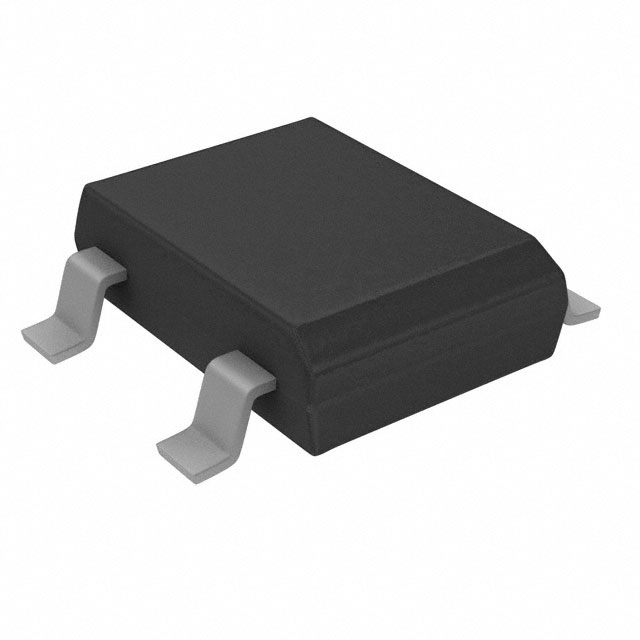Szczegóły produktu można znaleźć w specyfikacjach.

DB153STR Product Overview
Introduction
DB153STR is a semiconductor product belonging to the category of power diodes. This entry provides an overview of its basic information, specifications, pin configuration, functional features, advantages and disadvantages, working principles, application field plans, and alternative models.
Basic Information Overview
- Category: Power Diode
- Use: Rectification of high-power electrical signals
- Characteristics: High current-carrying capability, low forward voltage drop
- Package: TO-220AB
- Essence: Silicon-based semiconductor
- Packaging/Quantity: Typically packaged in reels or tubes containing multiple units
Specifications
- Maximum Forward Voltage: 1.2V
- Maximum Reverse Voltage: 300V
- Average Forward Current: 15A
- Peak Surge Current: 150A
- Operating Temperature Range: -55°C to 175°C
Detailed Pin Configuration
The DB153STR power diode has a standard TO-220AB package with three leads: 1. Anode (A) 2. Cathode (K) 3. Gate (G)
Functional Features
- High current-carrying capacity enables efficient power rectification
- Low forward voltage drop minimizes power loss
- Fast recovery time enhances switching performance
Advantages and Disadvantages
Advantages
- High current capability
- Low forward voltage drop
- Fast recovery time
Disadvantages
- Relatively large package size
- Limited reverse voltage rating
Working Principles
The DB153STR operates based on the principle of unidirectional conduction, allowing current flow in one direction while blocking it in the reverse direction. When forward-biased, it conducts current with minimal voltage drop, making it suitable for power rectification applications.
Detailed Application Field Plans
The DB153STR power diode finds extensive use in various applications, including: - Power supplies - Motor drives - Welding equipment - Battery chargers - Inverters
Detailed and Complete Alternative Models
Several alternative power diode models can be considered as substitutes for the DB153STR, including: - DB157STR: Higher reverse voltage rating - DB1510STR: Lower forward voltage drop - DB156STR: Smaller package size
In conclusion, the DB153STR power diode offers high current-carrying capability and low forward voltage drop, making it suitable for diverse power rectification applications. Its limitations include a relatively large package size and limited reverse voltage rating. Understanding its specifications, pin configuration, functional features, and alternative models is essential for effective utilization in various electronic circuits.
Word Count: 320
Wymień 10 typowych pytań i odpowiedzi związanych z zastosowaniem DB153STR w rozwiązaniach technicznych
Sure, here are 10 common questions and answers related to the application of DB153STR in technical solutions:
What is DB153STR?
- DB153STR is a type of strain gauge used for measuring strain or deformation in materials.
How does DB153STR work?
- DB153STR works by changing its electrical resistance in response to mechanical strain applied to the material it is attached to.
What are the typical applications of DB153STR?
- DB153STR is commonly used in structural health monitoring, load testing, and stress analysis in engineering and construction applications.
What are the advantages of using DB153STR in technical solutions?
- DB153STR offers high accuracy, reliability, and durability in measuring strain, making it suitable for critical structural monitoring.
How do I install DB153STR in my technical solution?
- DB153STR is typically bonded or attached to the surface of the material using adhesives or epoxies, and connected to a data acquisition system for measurement.
Can DB153STR be used in harsh environments?
- Yes, DB153STR is available in ruggedized versions that can withstand harsh environmental conditions such as extreme temperatures and vibrations.
What is the temperature range for DB153STR?
- The temperature range for DB153STR varies depending on the specific model, but many are designed to operate within a wide range of temperatures from -50°C to 150°C.
How often should DB153STR be calibrated?
- It is recommended to calibrate DB153STR periodically, typically every 6 to 12 months, or as specified by the manufacturer or industry standards.
Can DB153STR be used for dynamic strain measurements?
- Yes, there are dynamic strain gauge versions of DB153STR that are specifically designed for measuring rapid changes in strain.
Are there any limitations to using DB153STR in technical solutions?
- While DB153STR is highly accurate, it may have limitations in measuring very high strains or in applications with extreme electromagnetic interference.
I hope these questions and answers are helpful for your technical solutions involving DB153STR! If you need further assistance, feel free to ask.

